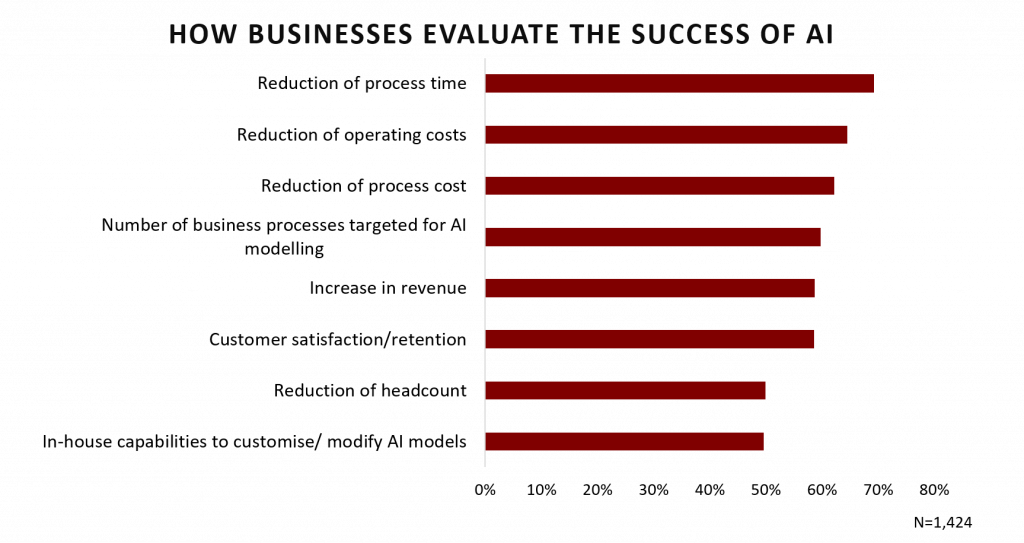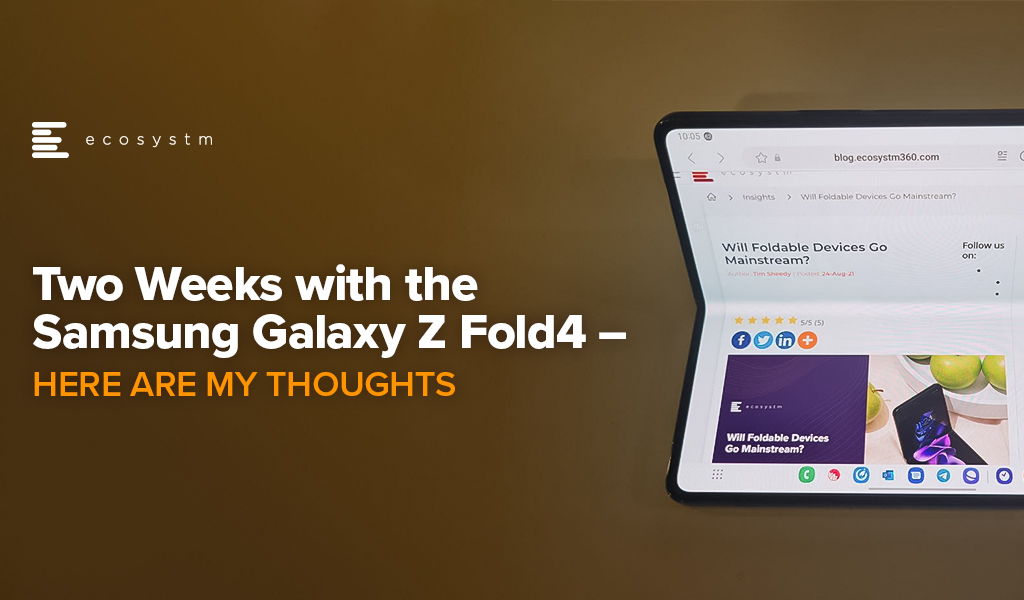If you have been following my insights and blogs at Ecosystm, it won’t come as a surprise that I am a fan of foldable devices. I have owned the Z Fold3 for over a year now. In that year, I found myself reaching for my tablet less often as the larger screen on the Z Fold3 was enough for most of my needs. Most apps were resized appropriately and provided an improved user experience, and the upgraded OS with a MacOS style application bar made it even easier to switch between applications.
The larger screen of the foldable form factor boosted my productivity too – I could use multiple applications and respond to an email with the content’s source (PDF, Excel file, website, etc.) also open – meaning far less flicking between apps, which isn’t as easy on a smartphone compared to a laptop or a desktop computer. The computer style view for messages and emails (with the email list on the left and the actual email on the right) was brilliant. And I enjoyed using the external screen as a preview screen for taking selfies (I already have my work cut out in making selfies look good! So, being able to see the picture in advance helps a lot).
However, Fold3 had its imperfections. The slightly narrow front screen made typing difficult when the device was folded – I primarily used it to check the status of things (such as turning my coffee machine on/off, checking my solar production, etc.). The inside screen also had durability issues. After a year, Samsung installed screen protector was coming off, and then, the right inner screen gave up completely on me. That said, Samsung has been excellent at fixing these issues under warranty.
Samsung Galaxy Z Fold4 – Enhanced Features
With the launch of the new Z Fold4, I was keen to get my hands on a trial device, and the good people at Samsung and their PR agency arranged that for me. I have now spent two weeks with this device. Despite it being similar in size to the Z Fold3, the upgrades do make a real difference:
- The few extra mm of width on the front screen makes it much more usable – I can now use this screen for typing messages and entering data. I still prefer the larger screen for things such as consuming content and typing longer emails. But the outside screen is usable for more than just checking the status of systems or apps.
- The shorter height and the wider screen mean that the inside screen now feels more “expansive” – more of a tablet experience – and is getting closer to an iPad mini. This makes consuming and creating content easier and more enjoyable. As an avid tablet user, even with the Z Fold3, I would hesitate when going out, wondering if I needed to take my iPad with me. I noticed that I did not hesitate with the Z Fold4 – I was fine without my tablet.
- Typically, newer phones feature improved cameras. This is certainly the case with the Z Fold4 – the camera feels faster than the Fold3, taking lesser time to focus and take pictures. And the images too are sharper and richer.
- The screen warranty has also improved – perhaps in acknowledgement of the issues with the Z Fold3 screen. There are specials offering screen replacements for a low cost, even if you damage the screen, as well as discounts on Samsung Care+, which offers two replacement devices in 24 months.
The only comment I have is that it is the most slippery phone I have used so far! It didn’t come with a protective case and in two weeks, I have dropped this phone more times than I have dropped any other phone in the past few years! It has slipped off seats and desks as well as out of my pocket and hands. Although, it does claim to “stand up to life’s bumps and fumbles” and this has been accurate so far (as it does not even have a scratch on it yet – which is a surprise as it has hit wood, tiles, and concrete pretty hard!). But if I were keeping the device for any longer, I would immediately purchase a case!
Who Will Use It Most?
Whether this device is right for you depends on your device use patterns. I do believe there is a case for businesses to invest in foldables – particularly for employees who share content one on one with clients or prospects, or those who want to be more productive and be away from their desks without lugging a laptop. Anyone who is considering a flagship phone with a larger screen (iPhone Pro Max or Pixel 7 Pro) should take a look at the Samsung Galaxy Z Fold4. You will be pleasantly surprised with the quality and capability of this device. I know I will be sad to see it go when I hand it back to Samsung!

I ran several roundtables over the past few weeks speaking to business and technology leaders about their AI investments – and one factor came up many times – that it is hard to build a business case for AI because 70% accuracy was not good enough…
What this means is that companies have thousands of things to automate. Most of those automations in the short-medium term will deliver 100% accuracy using RPA and other simple automation tools. Every time you run that process you know the outcome.
Along Comes AI and Machine Learning
These dumb processes can now learn – they can be smart. But originally they won’t deliver 100% accuracy. They might only deliver 60-70% to start with – climbing perhaps to 90%. The benefits of these smart, learning processes can amaze – costs can fall, processes can improve, outcomes can accelerate. But traditionally we have built technology business cases delivering 100% accuracy and outcomes.
So we need a new way to think about AI and a different language to use about the way it works. The people who sign off on the business cases might not understand AI – they will come to the business case with the same lens they use for all technology investments (and evidently – all business investments). We also need to be better at selling the benefits to our leaders. CEOs and Managing Directors in the roundtables are surprised to hear that AI won’t deliver 100% accuracy – they said unless they know more about the capability, savings and outcomes that the solution might drive, they are unlikely to fund it.
Make Your Dumb Processes Smart
I take this as good news. It means we have moved beyond the hype of AI – the need to “do AI in our business” that drove many of the poorer chatbots and machine learning projects. It means that businesses review AI investments in the same way as any business investment. But it also means we can’t over-promise or under-deliver on AI. Woodside did this with their initial foray into AI, and they are still playing catch up today.
While there are many opportunities to use “dumb automation” and save money, reduce or redeploy headcount – or have employees focus on higher value activities or make real differences to customer experiences – there are as many opportunities to make dumb processes smart. Being able to automatically read PDF or paper-based invoices – processes usually done by humans – could be a huge saving for your business. OK – maybe you can’t redeploy 100% of the staff, but 70% is still a big saving. Being able to take human error out of processes will often help to save money at two steps on the process – automating the human input function up front and also getting rid of the need to fix the mistake.
Start Your AI Journey With The Low Hanging Fruit
Ecosystm’s Global Ongoing AI study has shown that most businesses are focusing their AI investments on internal initiatives – on reducing process time, cost savings and driving productivity – which makes the most sense today. They are the easier business cases to build and the easiest benefits to explain.

Perhaps AI is also a chance for businesses to acknowledge that “efficient” does not always mean “good”. Many of the processes we automated or coded to ensure 100% compliance don’t give customers or employees what they are looking for. And maybe making the customer happy 70% of the time is better than not making them happy at all…
If you’d like to dig deeper into Ecosystm’s reports exploring the data from our ongoing AI study – check them out here (you’ll need to register if you have not already – it is free to register, but some content is premium):
4 Vendors Emerge as Leaders: Understanding the AI Vendor landscape
Use Cases Drive AI Software Adoption: Understanding The Industry Landscape



